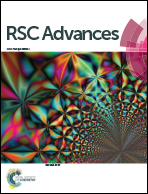Robust superhydrophobic and self-lubricating PTES-TiO2@UHMWPE fabric and its tribological properties†
Abstract
A superhydrophobic/self-lubricating fabric with double hierarchical structure was prepared by first etching pristine ultrahigh molecular weight polyethylene (UHMWPE) fibers with air-plasma, followed by a facile in situ growth method. Scanning electron microscopy (SEM) showed that the air-plasma etching treatment generated pits on the fiber surface and TiO2 was grafted onto the etched fiber, which greatly improved its surface roughness. The fabric was further modified by 1H,1H,2H,2H-perfluorodecyltriethoxysilane (PTES), which possesses a low surface free energy. The results showed the PTES-TiO2@UHMWPE fabric possessed superhydrophobic properties with a water contact angle (WCA) of 157.75°, enhanced thermal resistance, and exhibited excellent antiwear properties with a friction coefficient of 0.05. In addition, the PTES-TiO2@UHMWPE fabric retained its superhydrophobicity without an apparent reduction after 30 cycles of washing or 5 minutes of friction treatment, revealing its good mechanical properties. Meanwhile, the mechanical strength of the fabric had little reduction after UV irradiation, which is helpful in enlarging the fabric applications in industry.



 Please wait while we load your content...
Please wait while we load your content...